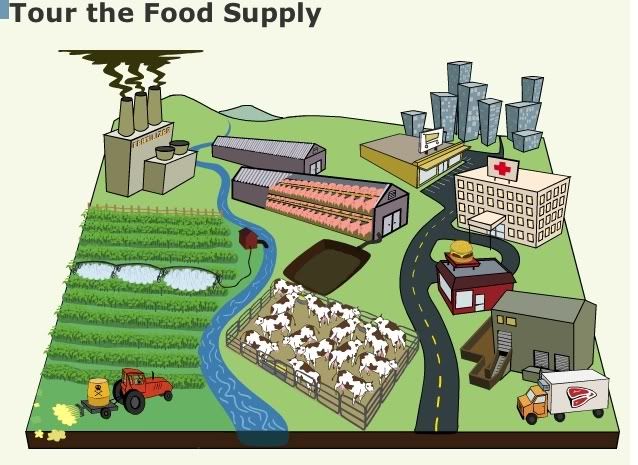
Take the tour...
For some reason, the Center for Science in the Public Interest didn't include information about the aquaculture industry's impact on ocean health in this interactive tour of the food supply. After all, Americans alone eat over 17 billion marine creatures every year - outweighing the global production of beef. I've been reading about the practices of intensive fish farming and open ocean fishing recently and I am seriously horrified (though not completely shocked) by what I've discovered. Really, all of this is very depressing.
Food, Ethics and the Environment Conference at Princeton: Concerns for Oceans, Climate and Animal Welfare from the University Channel
More...
Fish farming, or “aquaculture,” has become a billion-dollar industry, and more than 30 percent of all the sea animals consumed each year are now raised on these “farms.” The United Nations’ Food and Agriculture Organization reports that the aquaculture industry is growing three times faster than land-based animal agriculture, and fish farms will surely become even more prevalent as our natural fisheries become exhausted.
Aquafarms can be based on land or in the ocean. Land-based farms raise thousands of fish in ponds, pools, or concrete tanks. Ocean-based aquafarms are situated close to shorelines, and fish in these farms are packed into net or mesh cages. All fish farms are rife with pollution, disease, and suffering, regardless of their location.
Aquafarms squander resources—it can take 5 pounds of wild-caught fish to produce just 1 pound of farmed fish—and pollute the environment with tons of fish feces, antibiotic-laden fish feed, and diseased fish carcasses. The fish-farming industry’s demand for fishmeal and oil provides incentives for fleets to take millions of tons of small fish that otherwise might provide food for cod or haddock, and much needed protein for people in developing countries.
Fish on aquafarms spend their entire lives in cramped, filthy enclosures, and many suffer from parasitic infections, diseases, and debilitating injuries. Conditions on some farms are so horrendous that 40 percent of the fish may die before farmers can kill and package them for food.
Yet commercial fishers kill hundreds of billions of animals every year—far more than any other industry—and they’ve decimated our ocean ecosystems. In fact, 90 percent of large fish populations have been exterminated in the past 50 years and a recent report published in the academic journal Science, estimates that by the year 2048 our oceans will have been completely over-fished.
Today’s commercial fishers use massive ships the size of football fields and advanced electronic equipment and satellite communications to track fish. These enormous vessels can stay out at sea for as long as six months, storing thousands of tons of fish onboard in massive freezer compartments.
Commercial fishing boats leave their ports in pursuit of specific species of fish, but their hooks and nets bring up thousands of pounds of other marine animals as well. Sharks, sea turtles, birds, seals, whales, and other nontarget fish who get tangled in nets and hooked by long-lines are termed “bycatch” and are thrown overboard. They fall victim to swarming birds or slowly bleed to death in the water. Scientists recently found that nearly 1,000 marine mammals—dolphins, whales, and porpoises—die each day after they are caught in fishing nets. By some estimates, shrimp trawlers discard as much as 85 percent of their catch, making shrimp arguably the most environmentally destructive fish flesh a person can consume. Shrimp fishing amounts to only 2% of the global wild seafood catch, but is responsible for 30% of all by catch in the world's fisheries.
Commercial fishing is wiping out biodiversity, as miles of nets sweep up all the fish in their path—and take coral habitats with them. Commercial fishers have devastated the ocean’s ecosystem to the extent that large fish populations are only 10 percent of what they were in the 1950s. Wild Atlantic salmon are so few that 300 farmed fish are sold for every 1 caught swimming freely. In March of 2005 The New York Times revealed that 6 out of 8 stores were selling farmed salmon labeled (as the more expensive) wild salmon. Salmon is most commonly farmed by confining 50,000 animals to a single cage or net. The wild salmon population is, unfortunately, largely unsustainable due to the demand for wild caught fishmeal feed, oil, and the threat of disease and parasites from escaped farm fish. Seafood Watch suggests buying wild-caught salmon, but unless you have a trustworthy supplier, you are probably purchasing farm-raised meat.
The Ethics of What We Eat: Why Our Food Choices Matter (Singer and Mason)
http://www.nofishing.net/CommercialFishing.asp




4 comments:
And that is why eating fish is YUCKY!!
Indeed, sir. Indeed.
WE need fish. It is the only food we have left that contains all 72 trace elements. All of our food we grow only has 8. This is why there is so much illness. We need to be responsible with our fishing, it is too valuable a source not to. If you don't eat fish, then you aren't getting nearly enough trace elements. You are paving the way for cancers, mental disorders, neurological disorders. The reason there are only 8 in out grown food is because scientist saw that there were only trace amounts of these trace elements in our bodies and thought they were insignificant. For 150 years we ignored these trace elements and look, cancer rates have sky rocketed, diabetes rampant, heart disease and stroke number 1 killers...we need all 72 trace elements in our bodies. And because of modern chemical agriculture, we only get 8 and so the only source that still has all 72 trace minerals is seafood. 125 grams a day of any seafood is enough.
Who knows where to download XRumer 5.0 Palladium?
Help, please. All recommend this program to effectively advertise on the Internet, this is the best program!
Post a Comment